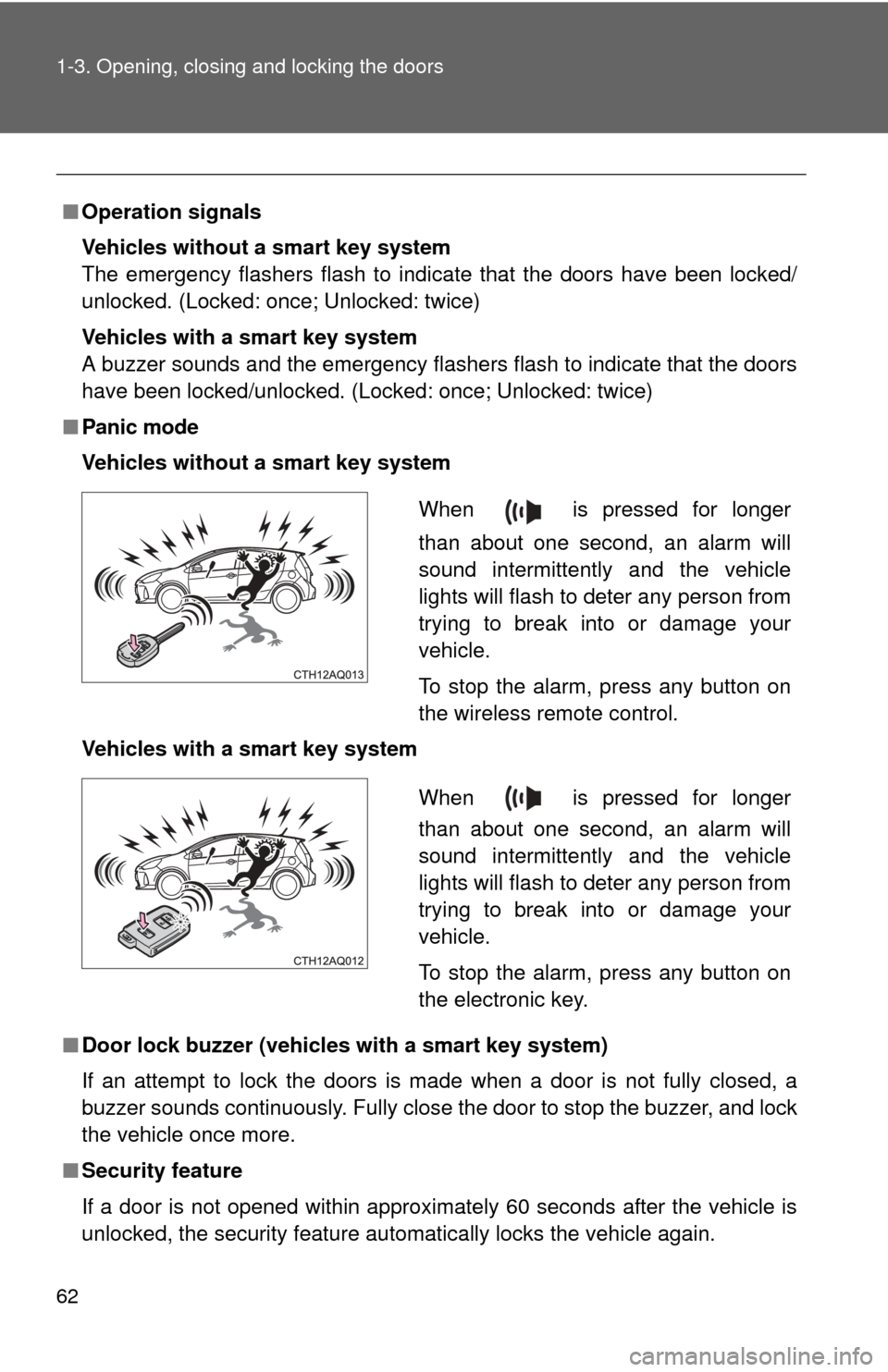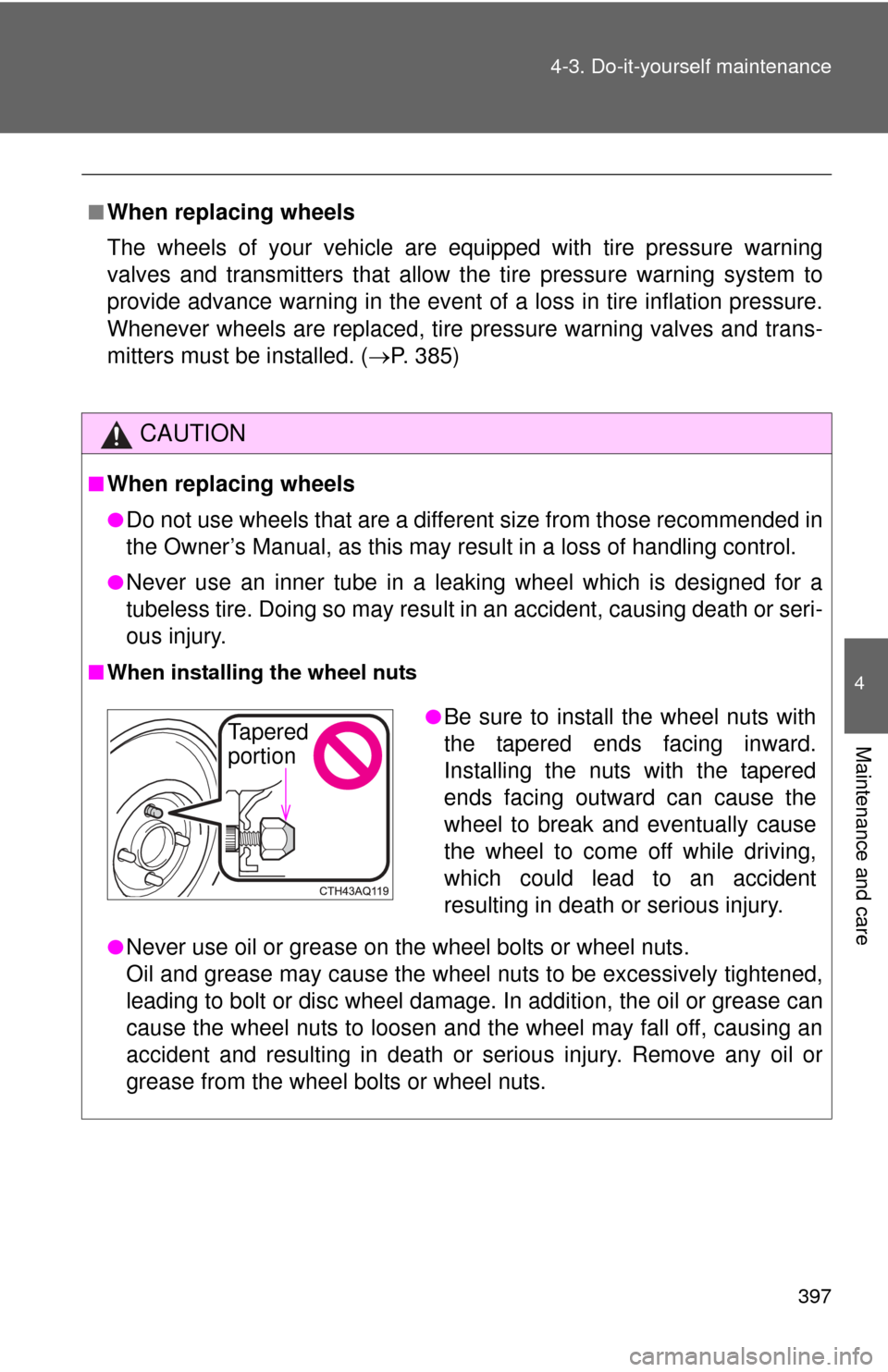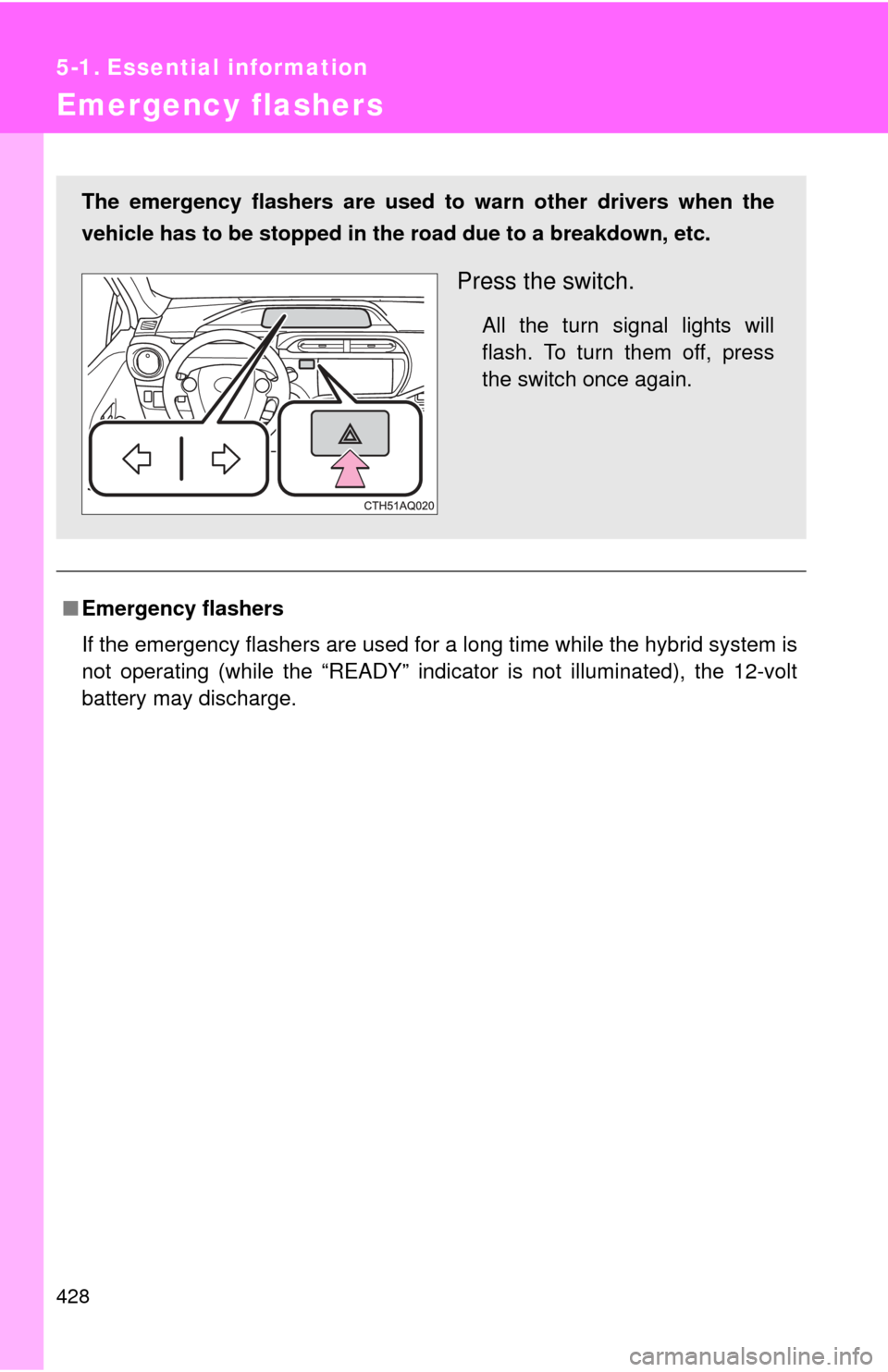Break TOYOTA PRIUS C 2014 NHP10 / 1.G Owners Manual
[x] Cancel search | Manufacturer: TOYOTA, Model Year: 2014, Model line: PRIUS C, Model: TOYOTA PRIUS C 2014 NHP10 / 1.GPages: 563, PDF Size: 8.89 MB
Page 63 of 563

62 1-3. Opening, closing and locking the doors
■Operation signals
Vehicles without a smart key system
The emergency flashers flash to indicate that the doors have been locked/
unlocked. (Locked: once; Unlocked: twice)
Vehicles with a smart key system
A buzzer sounds and the emergency flashers flash to indicate that the doors
have been locked/unlocked. (Locked: once; Unlocked: twice)
■Panic mode
Vehicles without a smart key system
Vehicles with a smart key system
■ Door lock buzzer (vehicl es with a smart key system)
If an attempt to lock the doors is made when a door is not fully closed, a
buzzer sounds continuously. Fully close the door to stop the buzzer, and lock
the vehicle once more.
■ Security feature
If a door is not opened within approximately 60 seconds after the vehicle is
unlocked, the security feature automatically locks the vehicle again.
When is pressed for longer
than about one second, an alarm will
sound intermittently and the vehicle
lights will flash to deter any person from
trying to break into or damage your
vehicle.
To stop the alarm, press any button on
the wireless remote control.
When is pressed for longer
than about one second, an alarm will
sound intermittently and the vehicle
lights will flash to deter any person from
trying to break into or damage your
vehicle.
To stop the alarm, press any button on
the electronic key.
Page 75 of 563

74 1-3. Opening, closing and locking the doors
CAUTION
●Do not pull on the back door damper stay to close the back door, and do
not hang on the back door damper stay.
Doing so may cause hands to be caught or the back door damper stay to
break, causing an accident.
● If a bicycle carrier or similar heavy object is attached to the back door, it
may suddenly shut again after being opened, causing someone’s hands,
head or neck to be caught and injured. When installing an accessory part
to the back door, using a genuine Toyota part is recommended.
●The back door may suddenly shut if it is
not opened fully. It is more difficult to
open or close the back door on an
incline than on a level surface, so
beware of the back door unexpectedly
opening or closing by itself. Make sure
that the back door is fully open and
secure before using the luggage com-
partment.
● When closing the back door, take extra
care to prevent your fingers etc. from
being caught.
● When closing the back door, make sure
to press it lightly on its outer surface. If
the back door handle is used to fully
close the back door, it may result in
hands or arms being caught.
Page 152 of 563

151
2-1. Driving procedures
2
When driving
Starting off on a steep uphill
Make sure that the parking brake is set and shift the shift lever
to D.
Gently depress the accelerator pedal.
Release the parking brake.
■When starting off on a uphill
The hill-start assist control will activate. ( P. 221)
■ Driving in the rain
●Drive carefully when it is raining, because visibility will be reduced, the
windows may become fogged-up, and the road will be slippery.
● Drive carefully when it starts to rain, because the road surface will be
especially slippery.
● Refrain from high speeds when driving on an expressway in the rain,
because there may be a layer of water between the tires and the road
surface, preventing the steering and brakes from operating properly.
■ Engine speed while driving
In the following conditions, the engine speed may become high while driving.
This is due to automatic up-shifting control or down-shifting implementation
to meet driving conditions. It does not indicate sudden acceleration.
●The vehicle is judged to be driving uphill or downhill
● When the accelerator pedal is released
■ Breaking in your new Toyota
To extend the life of the vehicle, observing the following precautions is rec-
ommended:
●For the first 200 miles (300 km):
Avoid sudden stops.
● For the first 1000 miles (1600 km):
• Do not drive at extremely high speeds.
• Avoid sudden acceleration.
• Do not drive at a constant speed for extended periods.
STEP1
STEP2
STEP3
Page 334 of 563

331
3-5. Using the
storage features
3
Interior features
NOTICE
■Items that should not be stowed in the bottle holders
Put the cap on before stowing a bottle. Do not place open bottles in the bot-
tle holders, or glasses and paper cups containing liquid. The contents may
spill and glasses may break.
Bottle holders
Page 400 of 563

397
4-3. Do-it-yourself maintenance
4
Maintenance and care
■When replacing wheels
The wheels of your vehicle are equipped with tire pressure warning
valves and transmitters that allow the tire pressure warning system to
provide advance warning in the event of a loss in tire inflation pressure.
Whenever wheels are replaced, tire pressure warning valves and trans-
mitters must be installed. (
P. 385)
CAUTION
■When replacing wheels
●Do not use wheels that are a different size from those recommended in
the Owner’s Manual, as this may resu lt in a loss of handling control.
●Never use an inner tube in a leaking wheel which is designed for a
tubeless tire. Doing so may result in an accident, causing death or seri-
ous injury.
■ When installing the wheel nuts
●
Never use oil or grease on the wheel bolts or wheel nuts.
Oil and grease may cause the wheel nuts to be excessively tightened,
leading to bolt or disc wheel damage. In addition, the oil or grease can
cause the wheel nuts to loosen and the wheel may fall off, causing an
accident and resulting in death or serious injury. Remove any oil or
grease from the wheel bolts or wheel nuts.
●Be sure to install the wheel nuts with
the tapered ends facing inward.
Installing the nuts with the tapered
ends facing outward can cause the
wheel to break and eventually cause
the wheel to come off while driving,
which could lead to an accident
resulting in death or serious injury.Tapered
portion
Page 417 of 563

414 4-3. Do-it-yourself maintenance
CAUTION
■To prevent system breakdowns and vehicle fire
Observe the following precautions.
Failure to do so may cause damage to the vehicle, and possibly a fire or
injury.
●Never use a fuse of a higher amperage rating than that indicated, or use
any other object in place of a fuse.
● Always use a genuine Toyota fuse or equivalent.
Never replace a fuse with a wire, even as a temporary fix.
● Do not modify the fuses or fuse boxes.
■ Fuse box near the power control unit
Never check or replace the fuses as there are high voltage parts and wiring
near the fuse box.
Doing so may cause electric shock, resulting in death or serious injury.
NOTICE
■Before replacing fuses
Have the cause of electrical overload determined and repaired by your
Toyota dealer as soon as possible.
Page 431 of 563

428
5-1. Essential information
Emergency flashers
■Emergency flashers
If the emergency flashers are used for a long time while the hybrid system is
not operating (while the “READY” indicator is not illuminated), the 12-volt
battery may discharge.
The emergency flashers are used to warn other drivers when the
vehicle has to be stopped in the road due to a breakdown, etc.
Press the switch.
All the turn signal lights will
flash. To turn them off, press
the switch once again.
Page 521 of 563

518 6-1. Specifications
Bead separationA breakdown of the bond between components
in the bead
Bias ply tire A pneumatic tire in which the ply cords that
extend to the beads are laid at alternate angles
substantially less than 90 degrees to the cen-
terline of the tread
Carcass The tire structure, except tread and sidewall
rubber which, when inflated, bears the load
Chunking The breaking away of pieces of the tread or
sidewall
Cord The strands forming the plies in the tire
Cord separation The parting of cords from adjacent rubber com-
pounds
Cracking Any parting within the tread, sidewall, or inner-
liner of the tire ext
ending to cord material
CT A pneumatic tire with an inverted flange tire
and rim system in which the rim is designed
with rim flanges pointed radially inward and the
tire is designed to fit on the underside of the
rim in a manner that encloses the rim flanges
inside the air cavity of the tire
Extra load tire A tire designed to operate at higher loads and
at higher inflation pressures than the corre-
sponding standard tire
Groove The space between two adjacent tread ribs
Innerliner The layer(s) forming the inside surface of a
tubeless tire that contains the inflating medium
within the tire
Innerliner separation The parting of the innerliner from cord material
in the carcass
Tire related termMeaning
Page 550 of 563

547
Alphabetical index
Back door................................... 71
Back-up lights
Replacing light bulbs ............ 415
Wattage ................................ 505
Battery
Checking .............................. 379
Hybrid battery (traction battery) ................... 29
If the vehicle 12-volt battery is discharged .......... 481
Preparing and checking
before winter ...................... 231
Bluetooth
® audio
Bluetooth® audio .................. 291
Portable player ..................... 300
Set up ................................... 308
Using the Bluetooth
®
audio .................................. 295
Bluetooth
® phone
Making a phone call ............. 303
Set up ................................... 314
Bottle holders .......................... 330
Brake Fluid...................................... 503
Parking brake ....................... 179
Brake assist ............................. 221
Break-in tips ............................ 151 Care
Exterior ..................................346
Interior ...................................349
Seat belts ..............................349
Cargo capacity .........................226
CD player ..................................256
Chains .......................................231
Child-protectors .........................67
Child restraint system
Booster seats, definition ........136
Booster seats, installation .....140
Convertible seats, definition .............................136
Convertible seats,
installation ...........................140
Front passenger occupant classification system ........... 130
Infant seat, definition .............136
Infant seats, installation.........140
Installing CRS with LATCH system........ ............141
Installing CRS with seat belts ............................142
Installing CRS with top tether straps ..................146
BC
Page 552 of 563

549
Alphabetical index
Doors
Back door ............................... 71
Door lock .................... 47, 61, 65
Door windows ......................... 98
Rear door child protector ........ 67
Side doors .............................. 65
Side mirrors ............................ 96
Driver’s seat belt reminder
light ........................................ 439
Driving Break-in tips ......................... 151
Correct posture..................... 114
Procedures ........................... 150
Winter driving tips ................. 231
Eco drive mode ....................... 176
Electric power steering........... 221
Electronic key If the electronic key does
not operate properly ........... 479
Emergency flashers Switch ................................... 428
Emergency, in case of If a warning buzzer sounds ............................... 437
If a warning light turns on .............................. 437
If a warning message is
displayed ............................ 447
If the electronic key does not operate properly ........... 479
If the hybrid system will not start .............................. 475
If the shift lever cannot
be shifted from P ................ 477
If the vehicle becomes stuck................................... 492
If the vehicle 12-volt battery is discharged .......... 481 If you have a flat tire .............463
If you lose your keys .............478
If you think something is
wrong ..................................436
If your vehicle has to
be stopped in an
emergency ..........................493
If your vehicle needs to
be towed .............................429
If your vehicle overheats .......487
Engine
Compartment ........................368
Engine switch ................160, 164
Hood......................................364
How to start the hybrid system ........................160, 164
Identification number .............497
If the hybrid system will
not start ...............................475
Ignition switch................160, 164
Overheating...........................487
“POWER” switch ...................164
Engine coolant
Capacity ................................500
Checking ...............................373
Preparing and checking before winter .......................231
E